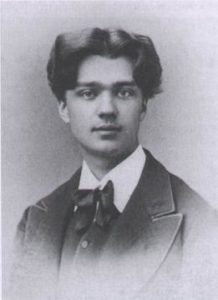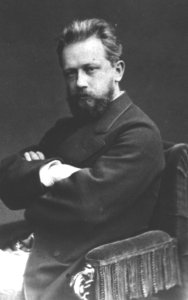On April 4, 6, and 7, the Houston Symphony presents a stirring all-Russian program featuring Rachmaninoff’s Piano Concerto No. 4 and Tchaikovsky’s Symphony No. 3. In this post, discover the personal, musical and cultural influences that shaped the delightful melodies of this most balletic of Tchaikovsky’s symphonies. Get tickets and more information here.
Tchaikovsky’s Third Symphony dates from his time as a professor at the Moscow Conservatory. As soon as the spring term of 1875 was over, he took off for Usovo, an idyllic Russian estate in Tambov province owned by a friend who played a significant role in this period of his life: Vladimir Shilovsky.
Tchaikovsky’s Fanboy

Tchaikovsky had first met Shilovsky some nine years earlier when he was a teenager in need of piano lessons. Tchaikovsky’s younger brother Modest later recalled that Shilovsky was “weak, sickly, with, as a result, a neglected education, but endowed, as it seemed then, with phenomenal capacities for music. In addition, his appearance was unusually attractive, his manners most spontaneously charming, and his mind, despite his poor education, sharp and observant.” Shilovsky’s wealthy parents hired Tchaikovsky, but he got perhaps more than he bargained for when Shilovsky fell head over heels in love with him.
Gossip soon began to circulate. “What lay behind this exceptional friendship, which amounted to schoolboy worship, was the topic of a great deal of quite unpleasant discussion at the time,” the journalist Alexandra Sokolova recalled. How far the relationship went is impossible to say for sure, but it seems likely that Shilovsky and Tchaikovsky became lovers for a time. For years, Shilovsky would regularly supplement his former teacher’s modest salary with generous gifts and invite him to both travel abroad and stay at his country estate.
Despite Shilovsky’s wealth, good looks, musical talent and adoration, Tchaikovsky had mixed feelings regarding his former pupil. On one instance he wrote that “I fear Shilovsky will poison all my pleasure by his mad behavior, in spite of promising and swearing in his letters that he will look after me, spoil me and generally pamper me….” Shilovsky possessed an erratic, temperamental personality and completely lacked the discipline needed to make something of his musical talent. Instead, he engaged in scandalous behavior: he once squandered an entire year’s income while on vacation; on another occasion, he dramatically left a (justifiably) jealous boyfriend to move in with someone else; on a trip abroad he ran down his delicate health so severely that Tchaikovsky had to rescue him at a sanatorium.
Shilovsky’s charms were invariably accompanied by drama, which exasperated Tchaikovsky to no end. Still, they were both part of the small world that was the gay community in 1870s Moscow, and even after their relationship cooled, the two remained on more or less friendly terms. Tchaikovsky would work on several of his compositions at Shilovsky’s estate, including his Second Symphony, his tone poem The Tempest, and his opera Vakula the Smith. The summer of 1875 would yield his Third Symphony, perhaps the greatest of his works composed there. In gratitude, Tchaikovsky dedicated the symphony to Shilovsky.
Magic and Majesty

In a letter, Tchaikovsky reported, “I’m now composing a new symphony, and I’m doing a bit at a time. I don’t sit over it for hours on end, and I’m walking more….Nothing’s changed here. Even the dogs are the same, and they chase after me to have a walk.” Daily walks were indispensable for Tchaikovsky’s creative process, and on previous visits to Usovo he had praised the beautiful landscape of the estate, a vast Russian steppe dotted with forests. Perhaps the relaxed atmosphere influenced the genial mood of this work, his only symphony in a major key. He completed the short-score draft of the symphony in just three weeks, and completed the orchestration by the end of the summer.
Perhaps influenced by the Third Symphony of Schumann (one of Tchaikovsky’s favorite composers), the symphony is in five movements rather than the usual four, with an extra intermezzo-like inner movement. Many commentators have noted the dancing, balletic character of much of the symphony (the choreographer George Balanchine would use most of the symphony for the Diamonds portion of his ballet Jewels). Indeed, before leaving Moscow, Tchaikovsky had been invited to compose the ballet Swan Lake, and he would begin work on it as he was finishing the orchestration of the symphony. It is entirely possible that he was thinking about both works simultaneously. The symphony also resembles his ballets (Swan Lake, Sleeping Beauty and The Nutcracker) with music evoking both monarchical pageantry and the supernatural.
The Music
The symphony begins with a slow introduction, which is suggestively marked “Tempo di marcia funebre” (“Tempo of a funeral march”):
The music creates a spooky, uncanny atmosphere as a halting melody is passed among strings, horns and woodwinds. A timpani drum roll then begins a grand crescendo as the music accelerates, dispelling the gloom of the introduction. The main theme of the movement arrives marked “Allegro brillante,” its rectilinear, march-like rhythms recalling the neoclassical architecture of Russian palaces. Skittering, shadowy music leads to a grand restatement of the theme, which immediately segues into an enchanting, minor-key melody for solo oboe. A colorfully orchestrated crescendo ends the exposition of the movement’s main themes.
A developmental section begins as the movement’s main themes are fragmented and overlapped with each other. The harmonies become increasingly unstable, only resolving with the brilliant return of the main theme. After a varied reprise of the other main ideas, the movement ends with a thrilling coda.
The second movement is an enchanting intermezzo titled “Alla tedesca” (“like a German dance”—a ländler or waltz). Its opening melody is a blend of simplicity and sophistication: on the surface, it is a simple tune in 3/4 time, but the accompaniment creates an entrancing ambiguity with shifting accents that displace the meter and harmonies that vacillate between major and minor. A contrasting middle section features light, will-o’-the-wisp triplets in the woodwinds.
The third movement, marked “Andante elegiaco” (“moderately slow, elegiac”), resembles other musical elegies Tchaikovsky wrote with its juxtaposition of despondency and nostalgia. After a brief introduction, a solo bassoon introduces a desolate melodic idea that wanders from one instrument to another until a lush theme for strings (marked “molto espressivo” or “very expressive”) emerges. After a brief, unsettled development, the “molto espressivo” theme returns in the woodwinds. A dramatic transition featuring tremolo strings leads to a return of the desolate bassoon theme, which brings the movement to a close.
A chill wind seems to blow through the fourth movement, a whirling Scherzo full of ingenious orchestral effects that hint at Swan Lake’s black magic. The flurries of sixteenth-notes only pause for a stiller, contrasting middle section. After a varied reprise of the opening, a brief coda recalling the theme of the middle section brings this impish movement to a close.
The finale, marked “Allegro con fuoco (tempo di Polacca)” or “Fast with fire (tempo of a polonaise),” begins with a vigorous polonaise theme for the full orchestra. This led to the work being nicknamed Tchaikovsky’s “Polish” Symphony after a London performance by the conductor August Manns in 1899, but in truth there is nothing Polish about it. The polonaise (a dance in triple meter with an accent on the second beat—1-2-3, 1-2-3) was a popular social dance with 19th-century Russia’s aristocracy. Processional in nature, it allowed couples to see and be seen, and its rhythms became musical shorthand for the pomp and splendor of the Tsar’s court:
After a transitional passage, the woodwinds intone a hymn-like second theme resembling a patriotic anthem. A brief reappearance of the polonaise segues to a refined, minor-key melody before returning in full. The polonaise then becomes the subject of a fugue, a kaleidoscopic musical texture in which a main idea is passed among different instruments and interwoven with countermelodies. The fugue reaches a low, sustained pedal note, above which the music crescendos to the apotheosis of the hymn-like second theme, which rings out with patriotic fervor from the brass:
https://www.youtube.com/watch?v=-JagoH8-7jw&t=1m9s
The polonaise is then transformed into an ecstatic coda, which races faster and faster toward the symphony’s thundering final chords.
Don’t miss Tchaikovsky’s Symphony No. 3, part of our Tchaikovsky & Rachmaninoff program April 4, 6, and 7, 2019! Visit houstonsymphony.org for tickets and more information.
We want to hear from you! Tell us what you think in the comments below.



